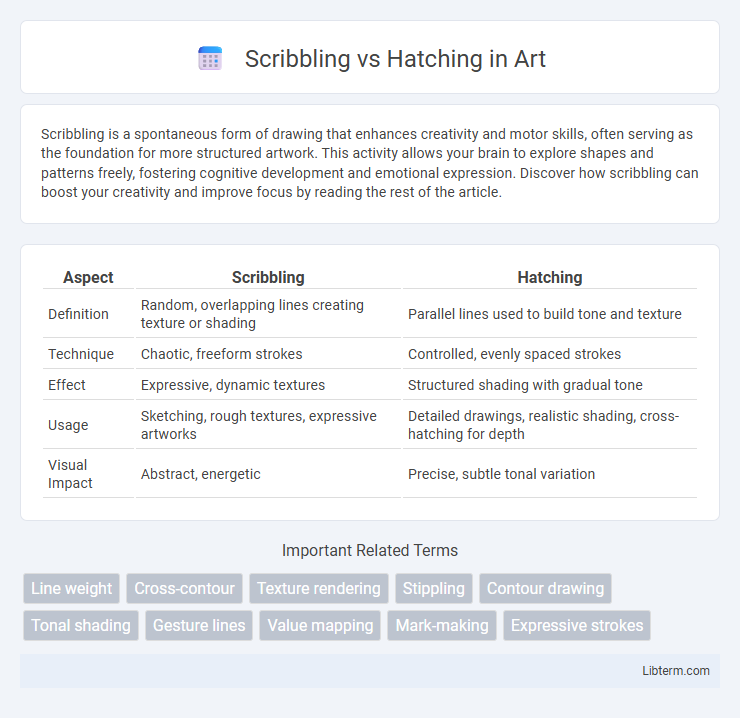Scribbling is a spontaneous form of drawing that enhances creativity and motor skills, often serving as the foundation for more structured artwork. This activity allows your brain to explore shapes and patterns freely, fostering cognitive development and emotional expression. Discover how scribbling can boost your creativity and improve focus by reading the rest of the article.
Table of Comparison
| Aspect | Scribbling | Hatching |
|---|---|---|
| Definition | Random, overlapping lines creating texture or shading | Parallel lines used to build tone and texture |
| Technique | Chaotic, freeform strokes | Controlled, evenly spaced strokes |
| Effect | Expressive, dynamic textures | Structured shading with gradual tone |
| Usage | Sketching, rough textures, expressive artworks | Detailed drawings, realistic shading, cross-hatching for depth |
| Visual Impact | Abstract, energetic | Precise, subtle tonal variation |
Introduction to Scribbling and Hatching
Scribbling and hatching are fundamental drawing techniques used to create texture, shading, and depth in artwork. Scribbling involves random, overlapping lines that form loose, expressive patterns, ideal for conveying energy and spontaneity. Hatching consists of closely spaced parallel lines that control shading and volume precisely, often varying in density and direction to depict light and shadow.
Defining Scribbling: Techniques and Styles
Scribbling, characterized by loose, continuous, and overlapping lines, creates texture and shading with an expressive, spontaneous style. Techniques include random, chaotic loops or rhythmic, repetitive marks that build tone through density and direction. Styles range from abstract, freeform sketches to controlled scribbles that define contours and volume in dynamic compositions.
Understanding Hatching: Methods and Variations
Hatching is a drawing technique involving closely spaced parallel lines to create tonal or shading effects, commonly used in pen and ink illustrations. Variations such as cross-hatching involve layering sets of lines at different angles to intensify shading and depth, while contour hatching follows the form of the subject to enhance three-dimensionality. Different methods like parallel, cross, and contour hatching provide artists with versatile approaches to texture, volume, and light representation in their works.
Visual Differences: Scribbling vs Hatching
Scribbling consists of irregular, loose, and overlapping lines that create texture and shading with a chaotic appearance, while hatching uses parallel, evenly spaced lines to build tone and depth more systematically. Scribbling results in a dense, freestyle pattern that conveys energy and spontaneity, whereas hatching emphasizes structure and form through controlled line direction and spacing. The visual contrast lies in scribbling's randomness versus hatching's ordered linearity, which affects the overall perception of light, shadow, and texture in artwork.
Artistic Purposes and Applications
Scribbling and hatching are distinct artistic techniques used to create texture, depth, and shading in drawings. Scribbling involves loose, overlapping lines to produce expressive, dynamic effects ideal for abstract and preliminary sketches, while hatching uses carefully spaced parallel lines to achieve precise tonal gradients and detailed form modeling in realistic artwork. Artists choose scribbling for spontaneous, energetic compositions and hatching for controlled, refined shading, enhancing visual interest and dimensionality.
Texture and Shading: Achieving Depth
Scribbling techniques create textured, dynamic surfaces by layering random, curved lines to build depth and shadow variations, making images appear more organic and lively. Hatching uses parallel lines with varying spacing and thickness to produce controlled gradients and smooth transitions between light and dark, enabling precise shading and dimensionality. Combining both methods enhances visual richness, with scribbling adding rough textures and hatching delivering refined tonal depth in artwork.
Tools and Materials for Each Technique
Scribbling relies on loose, irregular lines often created with graphite pencils, charcoal sticks, or ink pens on textured paper to enhance spontaneous mark-making. Hatching uses precise, parallel strokes typically executed with fine-tipped pens, colored pencils, or thin brushes on smooth paper to achieve controlled shading and tonal variation. Artists select specific tools like soft graphite for scribbling to produce varied line density, while hatching demands firm, consistent pressure from medium-hard pencils or technical pens for detailed layering.
Advantages and Limitations of Scribbling
Scribbling offers a spontaneous and energetic method of creating texture and volume in drawings, allowing artists to quickly build up shading and express emotions with loose, freeform lines. Its main advantage lies in its speed and ability to convey movement or chaos, but scribbling can lack precision and control, making it challenging to define detailed or realistic subjects. Limitations include potential visual clutter and difficulty in achieving fine gradations, which may restrict its use in more refined or delicate artwork.
Benefits and Challenges of Hatching
Hatching offers precise control over shading and texture, enabling artists to create depth and realism by varying line density and direction. This technique can challenge beginners due to the need for consistent, fine lines and careful spacing to avoid uneven tones. Despite these challenges, hatching enhances the ability to convey form and light, making it invaluable in detailed pen and pencil drawings.
Choosing the Right Technique for Your Artwork
Choosing between scribbling and hatching depends on the desired texture and mood in your artwork. Scribbling offers a loose, dynamic feel suitable for expressive and chaotic scenes, while hatching provides controlled shading and depth, ideal for realistic and detailed drawings. Artists should consider the intensity of light and shadow, as hatching excels in creating smooth gradients, whereas scribbling brings organic, spontaneous energy to the composition.
Scribbling Infographic

 libterm.com
libterm.com